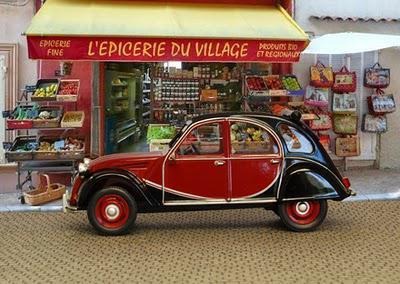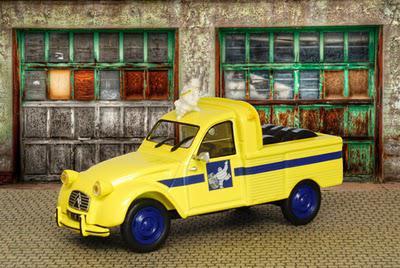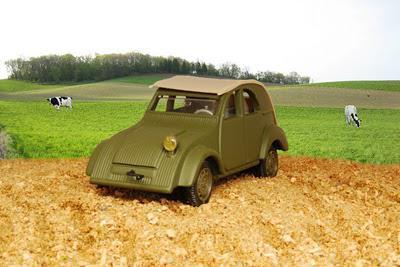
Here's one doing the shopping at the local village grocer's shop. This model with the red
and black colour scheme was called the Charleston, and I had to get one of those in
1:43 scale, as it's the only 2CV I have driven. In London, quite a while ago. I was thinking of
buying it to use as my 'travel around Europe in a car on my own' car. But it just didn't feel
comfortably up to all that long mileage, and so I bought a second-hand Citroen GS Club
instead. It handled its assignment well, but even it was a bit of a snail on theGerman
autobhans, with all those Porsches and BMWs whizzing by.I can't imagine how slow a
2CV would have been on an autobhan (but I would have stuck to the back roads if I had
a 2CV). This model is by Altaya, and they've captured the 2CV's charm quite well.

Having just one 2CV in my diecast cabinet wouldn't do, and the delightful 2CV van from
the Michelin series of cars put out by IXO was irresistible.I've plonked it on my faux
cobblestone road outside a suitably grimy garage.

And for my final diorama, and 2CV model, I have placed the 1939 Prototype out in the
French countryside, being put through its paces as a suitable workhorse for France's rural
community. Legend has it that the original design brief to Pierre-Jules Boulanger, the
designer of the 2CV, was for the proposed car to drive 100kg of farm goods to market at
60km/h, across muddy paved roads. Furthermore, it had to be able to cross a ploughed
field without breaking any of the eggs it was carrying on its front seat. And so here is
the wonderful prototype, with its cyclops-eye single headlight,doing just that – crossing
the field without making an omelette of the job. This little 1:43 model by Norev has
a wonky roof canvas that never stays flat, but I'll forgive it that blemish, as all
prototypes are a bit rough around the edges, aren't they?
All of this info I sort-of knew already, but the Wikipedia page on the 2CV does the little car proud, so if you want to read more about them, head there. However, to finish off this little homage to the 2CV I like to show you one in action. There are lots of 2CV videos on You Tube, of course. These cars are irresistibly photogenic and telegenic. There's one video about the famous legend that you can't roll a 2CV on a flat piece of road. Going forwards, that's true, but going backwards, it's not. You can watch that spoilsport one here.
However, I have no interest in trashing 2CVs. I just like to see them happy, doing what they so charmingly do, bouncing along on that suspension, crossing open fields.


